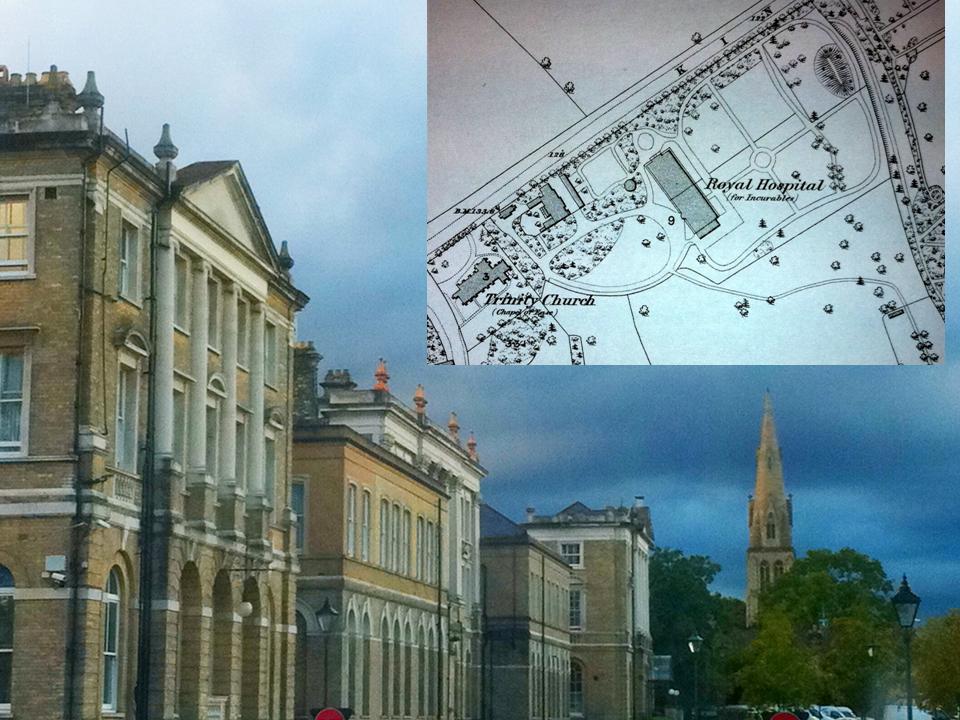
By our roving blogger Dr Susanna Park
Directly over the fence from my new home, there lies a complex with an impressive Victorian façade, proclaimed as the Royal Hospital for Neuro-Disability. It is clear that this facility has been operating here for a long time, probably ever since the Victorian era. What was the history of this hospital next door and how did it come to occupy such a stately building? My interest was further piqued when I found an old map of the area and written in small italic print was ‘Hospital for Incurables’.
The Hospital for Incurables was founded in 1854 by the distinguished philanthropist Dr Andrew Reed and moved to its current location, a former part of the Lord Spencer’s estate with 25 acres of gardens in 1863. Florence Nightingale advised on the design and the estate was supported by notable personalities of the day such as Charles Dickens, as well as several distinguished royal patrons. At the time, there were very few options for poor patients with so-called ‘incurable’ conditions 1. Most prominent hospitals of the day were designated as facilities for patients with acutely curable disease and often specifically excluded incurables in their charters 2. The difficulties experienced by incurable patients in obtaining care were commonplace in the 19th century. In the United States, hospitals also routinely excluded patients with incurable diseases from hospital beds3. The term ‘incurable’ was typically reserved for chronic diseases which required long-term care, such as cancer or tuberculosis 3.
The Hospital for Incurables became the only facility specifically designed for such patients in London at the time, although there were “270 hospitals and infirmaries for curable patients” in London in 1860 4. Over time the focus of the hospital has shifted towards neurological conditions, perhaps as public consideration of cancer and tuberculosis as incurable, untreatable diseases has changed.
In his 2009 book Incurable and Intolerable: Chronic Disease and Slow Death in Nineteenth Century France, Jason Szabo suggests that the development of treatments for chronic diseases in the 19th century was hindered by the widespread belief in their incurability 5. Szabo writes that “A critical early step in this crusade involved questioning the scientific validity and social consequences of the term incurable.” Perhaps in line with this type of thinking, the Hospital for Incurables changed its name to the Royal Hospital for Neuro-Disability in 1995. Currently, the focus is on assessment, treatment, care and rehabilitation for patients with neurological disability.
The question remains – Can semantics get in the way of progress? As with cancer and tuberculosis, is it possible that our current attitudes as to the incurability and hopelessness of neurological disorders are hampering the fight to convert these into chronic but treatable conditions? Spinal cord injury, traumatic brain injury, neurodegenerative disease – do these disorders represent the new frontier in the redefining the boundaries of possibility? Perhaps the words of Charles Dickens, in his weekly journal ‘All the year round’ sum it up best: “What is meant by Incurable? A disease called incurable in one generation, is curable in the next. A disease incurable by one man, is curable by another. A disease called curable, ends in a painful death; a disease called incurable, is borne with little suffering through a long life, and after all is not the cause of death”.6
References
1. Royal Hospital for Neuro-disability http://www.rhn.org.uk/
2. Cook GC. 2004. Caring for “incurables”: the 150th Anniversary of the Royal Hospital of Neuro-Disability, Putney. Postgraduate Medical Journal; 80: 426-430.
3. Abel EK. 2011. “In the last stages of irremediable disease”: American hospitals and dying patients before World War II. Bulletin of the History of Medicine; 85:29-56.
4. Elliot & Cobbe. 1860. Destitute Incurables in Workhouses: A paper by Miss Elliot and Miss Cobbe, read at the Social Science Meeting at Glasgow, September 1860: London: James Nisbet and Co.
5. Szabo J. Incurable and Intolerable: Chronic disease and slow death in Nineteenth Century France. New Brunswick New Jersey; Rutgers University Press. 2009.
6. Dickens C. 1861. All the year round: a weekly journal conducted by Charles Dickens. Volume V, March 30 to September 21, 1861 London: Chapman and Hall: 44-45.
Map segment from Old Ordinance Survey Maps, Putney 1866 London sheet 113, Alan Godfrey Maps
|
|